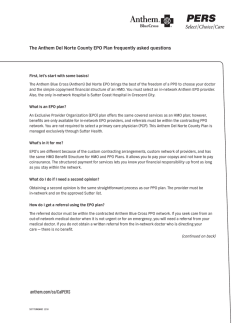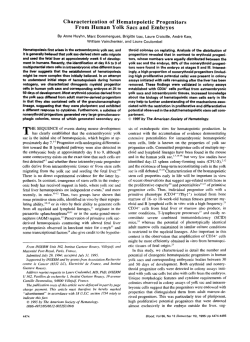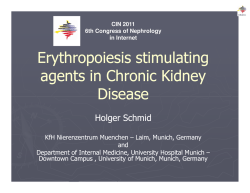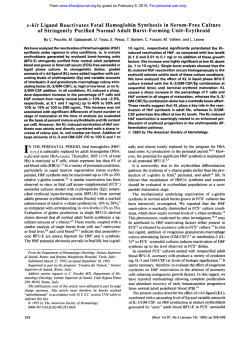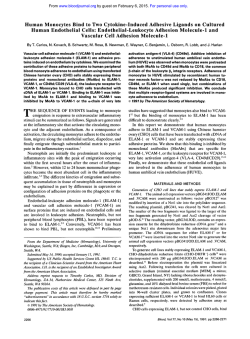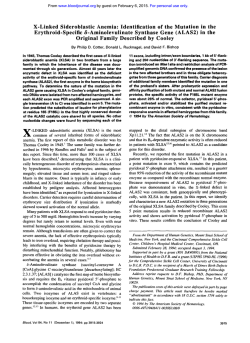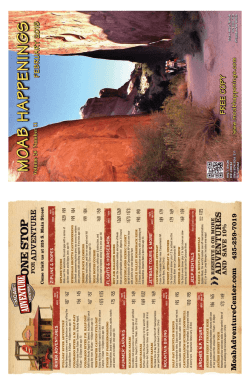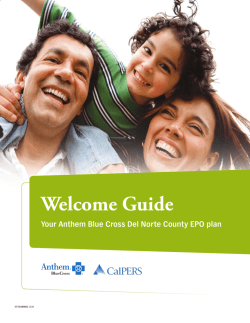
Anti-Erythropoietin (EPO) Receptor Monoclonal Antibodies
Anti-Erythropoietin (EPO) Receptor Monoclonal Antibodies Distinguish EPO-Dependent and EPO-Independent Erythroid Progenitors in Polycythemia Vera By Michael J. Fisher, Jaroslav F . Prchal, Josef T. Prchal, and Alan D. D’Andrea Erythroid progenitorcells isolated from patients with polycythemia vera (PV) proliferate and differentiate in methylcellulose in the absence of exogenous erythropoietin (EPO). To investigate the potential role of the erythropoietin receptor (EPO-R) in the pathogenesis of PV, we cultured bone marrow-derived or peripheral blood-derived erythroid progenitors in the presence of neutralizing monoclonal antibodies (MoAbs) specific for EPO or EPO-R. Mononuclear cells were obtained from 9 healthy adults and 9 PV patients byFicollHypaque gradients and cultured with or without EPO in methylcellulose for 12 days under standard or serum-free conditions. Neutralizing anti-EPO and anti-EPO-R MoAbs, added t o cultures at day 0, caused dose-dependent growth inhibition of all normal burst-forming units-erythroid(BFUE) derived from healthy adult controls. The MoAbs had no effect on the growth of nonerythroid progenitorcells under the same culture conditions. In contrast, neutralizing anti- bodies distinguished two classes of BFU-E derived from PV patients. Class I BFU-E from PV patients were EPO-dependent. These progenitors, like those derived from healthy adults, had normalEPO dose-dependent growth characteristics and showed a normal period of EPO requirement in vitro that extended 6 days after the initiation of culture. These results indicatethat EPO exerts its critical effect early during erythroid differentiation; the addiiion of neutralizing antibodies t o normal progenitors after 6 days had no effect on the subsequent size or maturation of the colonies. Class II BFU-E from PV patients wereEPO-independent. They proliierated and differentiated even in the presence of high concentrations of neutralizing anti-EPO or anti-EPO-R MoAbs. We conclude that the class II BFU-E from PV patients are independent of free EPO. 0 1994 by The Americen Society of Hematology. P ture erythroblasts. The human EPO-R is a 508 amino acid membrane protein and is a member of the cytokine receptor ~uperfamily.’~,’~ The number of EPO-R per cell surface increases as a BFU-E matures to a colony-forming unit-erythroid (CFU-E) but then decreases serially as a CFU-E matures to a reticu10cyte.l~~’~ Mature erythrocytes have no cell surface EPO-R (D’Andrea, unpublished observation). Ectopic expression of the human EPO-R polypeptide in a murine cell line, Ba/F3, confers EPO binding, EPO-dependent growth, and EPO-dependent erythroid differentiation.” Several lines of evidence suggest that the EPO-Rmay play a role in PV. First, the EPO-R plays a central role in the pathogenesis of one form of murine polycythemia?’ In this disease, the glycoprotein gp55 of the Friend spleen focus-forming virus binds to the murine EPO-R and constitutively activates the receptor, giving rise to EPO-independent polycythemia and eventually to erythroleukemia. Secondly, some studies suggest that the EPO-R is altered or defective in the erythroblasts from human subjects with PV. Whereas normal CFU-E appear to have both high- and low-affinity EPO-binding sites:’ CFU-E from patients with PVhave only a single class of low-affinity EPO-R (kd = 720 pmoVL).” Loss of the high-affinity binding site onPV erythroblasts could account for the loss of EPO-dependence. Third, mutations in the EPO-R polypeptide alter its inherent sensitivity to EP0.23Truncation of the carboxy terminal 70 amino acids of the human EPO-R is one cause of familial erythro~ y t o s i s . ’ ~It. ~is ~ therefore plausible that mutations in the human EPO-R could account for the altered sensitivity of PV cells to EPO for at least a subpopulation of patients. Other mutations in the EPO-R have been found that result in the constitutive activation of this receptor. A point mutation (R129C) results in the constitutive homodimerization of the murine EPO-R and signal transduction in the absence of EP0.27Such a mutation could account for the EPO-independent growth of erythroblasts from patients withPV. Moreover, the effect of an activated EPO-Rneednot be restricted to erythroid cells. Recent studies have shown that OLYCYTHEMIA VERA (PV) is a clonal myeloproliferative disorder, characterized by erythrocytosis and, in some cases, by elevations of granulocytes and platelets. The increased redblood cell production in PV is not the result of increased erythropoietin (EPO) production. For PV patients, circulating serum levels of EPO are normal’ or lower than normal.’ Instead, erythrocytosis results from proliferation of an abnormal clone of erythroid progenitor^.^.^ Some studies suggest that the abnormal clone is independent of EPO.”’ Other studies suggest that the abnormal clone is hypersensitive, but still dependent, on EP0.9”2 More recently, the growth characteristics of PV burst-forming unitserythroid (BFU-E) in response to other hematopoietic growth factors has been evaluated. BFU-E from PV subjects were found to be hypersensitive to insulin-like growth factor-] (IGF-l)” or to interleukin-3 (IL-3).I4 EPO initiates its cellular response by binding to the EPO receptor (EPO-R) that is expressed on the surface of imrnaFrom the Division of Pediatric Oncology and Division of Cellular and Molecular Biology, Dana-Farber Cancer Institute, Harvard Medical School, Boston, MA; the Departments of Medicine and Oncology of McGill University, Montreal, Quebec, Canada; and the Department of Medicine, Division of Hematology/Oncology, University of Alabama at Birmingham, AL. Submitted October 5, 1993; accepted May 13, 1994. Supported by a grant from National Institutes of Health (Award No. R 0 1 DK 43889-01) (A.D.D.),by the Sandoz Corp (A.D.D.),and by the HHMI (M.J.F.). A.D.D.is a Lucille P. Markey Scholar. Also supported in part by a grant from the Lucille P. Markey Charitable Trust. Address reprint requests to Alan D.D’Andrea, MD, Pediatric Oncology, Dana-FarberCancer Institute, 44 Binney St, Boston, MA 02115. The publication costsof this article weredefrayed in part by page charge payment. This article must therefore be hereby marked “advertisement” in accordance with 18 V.S.C. section 1734 solely to indicate this fact. 0 1994 by The American Society of Hematology. 0006-497I/94/8406-OOI 7$3.00/0 1982 Blood, Vol 84, No 6 (September 15). 1994 pp 1982-1991 1983 ANTI-€PO RECEPTOR MONOCLONAL ANTIBODIES the R129C EPO-R may be functionally expressed in megakaryocytes, perhaps accounting for the thrombocytosis observed in PV.28.29 To study the potential role of the EPO-R in the pathogenesis of PV, we have used neutralizing monoclonal antibodies (MoAbs) that bind to either EP03’ or EPO-R.31Our results confirm that both EPO-dependent erythroid progenitors and EPO-independent erythroid progenitors are present in the bone marrow and peripheral blood of patients with PV. The EPO-dependent progenitor cells from PV patients are indistinguishable from the progenitors of normal adult controls with regard to their EPO sensitivity and their developmental stage of EPO requirement. In contrast, the EPO-independent progenitor cells from PV are not inhibited by neutralizing concentrations of anti-EPO or anti-EPO-R at any time during their 12-day development into burst colonies. MATERIALS AND METHODS Subjects. PV patients were selected according to the following guidelines. All patients had increased red blood cell volume (males, 2 3 6 mL/kg; females, 2 3 2 mwkg) and normal arterial oxygen saturation (292%) and either splenomegaly or two of the following: thrombocytosis (>400,000/pL), leukocytosis (> 12,000 cells/pL), increased leukocyte alkaline phosphatase, or increased serum vitamin BIZ(>900 pg/mL). No subjects had been treated with hydroxyurea in the 3 months before study. Normal subjects were adult volunteers. All peripheral blood or bone marrow samples were obtained via the guidelines of our institutional review boards for human subject experimentation. Materials. Recombinant human EPO was a generous gift from Kirin Brewery (Tokyo, Japan) (specific activity, 300,000 U/mg). Stem cell factor (SCF) and recombinant human L - 3 were generously provided by Genetics Institute (Cambridge, MA). MoAbs were previously described. MoAb 5.5.1 1 is a neutralizing anti-EPO MoAb.” MoAb 16.5.1 is a neutralizing anti-EPO-R MoAb?‘ MoAb stocks were prepared as 1 mg/mLin phosphate-buffered saline (PBS; GIBCO, Grand Island, NY). All growth factors and MoAbs were stored at -80°C. Cell cultures. Peripheral blood was obtained by venupuncture, and bone marrow was obtained by aspiration from the posterior iliac crest. Mononuclear cells were isolated by separation over FicollPaque (Pharmacia, Uppsala, Sweden). Cells were washed three times in Iscove’s modified Dulbecco’s medium (IMDM; GIBCO) and plated at various concentrations (50,000 to 200,000 cells/mL) in standard l-mL methylcellulose (MC) cultures containing 0.9% MC (Teny Fox Laboratories, Vancouver, BC, Canada), 30% heat-inactivated fetal calf serum (FCS; HyClone Laboratories, Logan, UT), 2mercaptoethanol m o m ; Sigma, St Louis, MO), and either 10% leukocyte-conditioned medium or 0.9% bovine serum albumin (BSA; Fraction V; Sigma) that was deionized with an analytical grade mixed bed resin (BioRad, Richmond, CA), 0.05% NaHC03, 2 mmoyL glutamine, penicillin, streptomycin, 50 ng/mL SCF, and 20 ng/mL IL-3.” Alternatively, for serum-free cultures, FCS was omitted and transferrin (300 pg/mL; Boehringer Mannheim, Indianapolis, IN), bovine pancreas insulin (10 pg/mL; Sigma), and BSAmom) were added. adsorbed cholesterol (2 X Cultures were plated in duplicate in the presence or absence of 1 U/mL EPO. Before plating, one of the following was added to the plates: (1) no Ab, (2) anti-EPO-R MoAb, (3) anti-EPO MoAb, or (4) control MoAb (either a nonneutralizing anti-EPO-R MoAb, a nonneutralizing anti-EPO MoAb, or MOP-C21 [an IgGlk MoAb provided by Genetics Institute]). Alternatively, in the indicated experiments, cells were plated in MC cultures first and MoAbs were added dropwise to the center of the plate at various times after the initiation of culture. Final MoAb concentration was 60 nmol/L in l-ml MC plates. Cultures were incubated at 37°C and 5% CO2 until assessment of colony formation at day 7 (CFU-E) or day 12 (BFUE and nonerythroid colonies) using standard criteria for colony clas~ification.~~ BFU-E colony size ranged from 50 to 1,000 hemoglobinized cells. Results are expressed as the average number of colonies from duplicate cultures per 1 6 cells. BaF3 cells were maintained in RPMI plus 10% FCS plus 10% WEHI-conditioned media, as previously described. The human erythroleukemia cell lines K562,34OCIMI?’ and TF-l” were grown in RPMI plus 10% FCS. Generation of BdF3 cells expressing a constitutively activated human EPO-R. PXM-hEPO-R, encoding the full-length human EPO-R cDNA, has previously been described.” The R129C mutation of the human EPO-R (hEPO-R-C) was generated by the M13 mutagenesis method (BioRad). PXM-hEPO-R or PXM-hEPO-R-C were electroporated into parental, IL-3-dependent BaF3 cells, as previously de~cribed.’~ Individual BaF3 subclones were isolated by limiting dilution. Expression of either wild-type hEPO-R or hEPOR-C polypeptides was confirmed by immunoprecipitation, as previously de~cribed.’~ Flow cytornetric analysis. The indicated cell lines (2 X 10’ cells) were incubated withan anti-hEPO-R MoAb (MoAb 16.5.1; 13 nmom) and were stained with fluorescein isothiocyanate (FITC)conjugated antimouse second antibody. Cells were analyzed by FACScan (Becton Dickinson, San Jose, CA), as previously de~cribed.~’ EPO-dependentgrowthassay. The indicated cell lines were grown in plain media (RPMI + 10% FCS with no supplemental growth factor) or EPO-supplemented media, as previously des~ribed.’~ To assay factor-independent growth, cells were washed twice in plain media and resuspended in plain media. Cells (2 X 104/100pL) were added to multiple wells of a 96-well plate. Supplemental EPO or anti-EPO-R MoAb was added as indicated and growth was measured after 48 hours by the M’IT reduction assay.” RESULTS Anti-EPO-R MoAbs inhibit the growth of normal erythroid progenitors. To establish that the neutralizing MoAbs specifically inhibit erythroid progenitor growth and to determine appropriate neutralizing concentrations, progenitor cells from a normal subject were plated in cultures containing 1 U/mL of EPO in the presence of various concentrations of anti-EPO-R MoAb, anti-EPO MoAb, or a control Ab. Cultures were incubated until assessment of colony formation on day 12.Anti-EPO-R MoAb and anti-EPO MoAb demonstrated dose-dependent inhibition of EPO-mediated growth of erythroid colonies (Fig 1A). The concentration of MoAb that yielded one-half maximal inhibition was 1 nmoVL for both the anti-EPO-R MoAb and the anti-EPO MoAb. This concentration was similar to that required for inhibition of EPO-dependent cell line^.^',^' In contrast, neither MoAb inhibited the formation of nonerythroid colonies in methylcellulose culture (Fig 1B). PV patients have EPO-dependent and EPO-independent erythroid progenitors. To examine the importance of the interaction between EPO and the EPO-R in PV, progenitor cells were plated in standard methylcellulose cultures in the presence or absence of 1 U/mL EPO. Before plating, neutralizing concentrations of one of the following was added to the plates: no Ab, anti-EPO-R MoAb, anti-EPO MoAb, FISHER ET AL i A B c ‘5: 10-5 104 109 10-2 IO-1 loo lo1 102 103 1 I MoAb Concentratlon (nM) 0 IO= lo4 loo 10’ lo2 MoAb Concentration (nM) loJ lo4 10‘’ 10’ 10‘ Fig 1. Anti-EPO-R MoAbs inhibit the growthof normal erythroid progenitors. Progenitor cells (1.5 x lo5)from a normal subject were plated in standard methylcellulose cultures containing l UlmL of EPO in the presence of various concentrations of anti-EPO-R MoAb (01, anti-EPO MoAb (m), or a control MoAb (0). Cultures were assessed on day 12 for (A) BFU-E and (B) nonerythroid colony growth. or a control Ab. Cultures were then incubated at 37°C until assessment of colony formation at day 12. A representative example of 1 of 9 PV patients examined as well as a normal control are shown in Fig 2. Normal erythroid progenitors exhibited no growth without the addition of EPO. When EPO was added, there was growth of approximately SO colonies. This normal erythroid colony growth was blocked by anti-EPO-R and anti-EPO MoAbs, but not by the control Ab (Fig 2A). The PV subject had EPO-independent BFU-E that persisted even in the presence of neutralizing concentrations of anti-EPO-R MoAb and anti-EPO MoAb. In addition, the PV subject had normal erythroid progenitors that were dependent on EPO and were suppressed by the MoAbs. The inhibition was to the level of the EPO-independent number of colonies (Fig 2B). These findings suggest that, in addition tonormal EPO-dependent erythroid progenitors, an EPOindependent population of erythroid progenitors exists in PV. This population is not sensitive to anti-EPO or anti-EPOR MoAbs. Depicted in Fig 2C and D is the nonerythroid colony formation for the same two subjects. There was no effect of any of the MoAbs on nonerythroid colony formation. The inhibitory effects of the MoAbs were therefore specific for erythroid colony formation and not caused by a nonspecific toxic effect. To rule out the possibility thatthe PV progenitors are responding to a minute amount of EPO thought to be present in the fetal bovine serum usedin the culture media, we repeated this experiment in serum-free cultures (Fig 3). As above, a PV subject had a subset of erythroid progenitors that was EPO-independent in serum-free cultures (approximately 50 colonies) and a subset of normal erythroid progenitorsthat responded to EPO (approximately 100 colonies; Fig 3B). As in Fig 2, the EPO-dependent colonies, but not the EPO-independent colonies, were inhibited by anti-EPO and anti-EPO-R MoAbs. This inhibitory effect was specific; none of the MoAbs effected nonerythroid colony growth (Fig 3D).Normal control progenitor cells wereplatedin parallel (Fig 3A and C). The results of progenitor studies from 18 subjects (9 normal controls and 9 PV patients) are presented in Table 1. All 9 PV subjects had a mixture of EPO-independent and EPO-dependent erythroid progenitors. No differences were observed in the size of the EPO-independent and EPO-dependent colonies. All 9 normal controls had only EPO-dependent progenitors. These results were obtained irrespective of the source of mononuclear cells (bone marrow or peripheral blood) and irrespective of the culture conditions (serum versus serum-free). The anti-EPO and anti-EPO-R MoAbs did not inhibit the growth of nonerythroid colonies in any of the cultures (data not shown). For PV subjects, on average, 71.2% of the colonies were EPO-dependent (range, 43.5% to 92.4%) and 28.8% of the colonies were EPO-independent (range, 7.6% to 56.6%). There was no correlation between the percentage of EPO independent colonies and the hematocrits of the individual patients (data not shown). EPO-dependent growth of erythroid progenitors fromPV patients and from normal controls. To further evaluate the possibility that PV erythroid progenitors are hypersensitive to the growth effects of EPO, progenitor cells from 3 PV and 3 normal subjects wereplatedin parallel in standard methylcellulose cultures in the presence of various concentrations of EPO (Fig 4). Cultures were scored at day 12 for colony formation. For the 3 PV subjects, 16% to 24% of the bursts arose from EPO-independent progenitor cells (Fig 4, Y-intercept). When the growth of these EPO-independent cells was subtracted and the PV EPO-dependent progenitors were evaluated separately, theyhad EPO responsiveness similar to progenitors from the normal controls (Fig 4, inset, P > .lo). Anti-EPO and anti-EPO-R MoAbs define a critical period of EPO requirement early after the initiation of culture. Normal erythroid progenitors mature through defined stages, from undifferentiated BFU-E to C m - E to mature erythro- ANTI-EPO RECEPTOR MONOCLONAL ANTIBODIES 1985 PV Subject Normal Subject 80 -v) 3 1 ''1T 60 v) 807 A 0 h 40 Y i -* E m 0 20 - EPO + EPO - EPO + EPO - EPO + EPO T- D - EPO + EPO Fig 2. PV patients have EPO-dependent and EPO-independent erythroid progenitors in serum-containing cultures. Progenitor cells were plated in standard methylcellulose culturesin t h e presence or absence of 1 U/mL EPO. Before plating, a neutralizing concentration (60 nmol/ L) of one of the following was added to the plates: no MoAb (W), anti-EPO-R MoAb (B),anti-EPO MoAb LO), or a control MoAb (7). Cultures were assessed o n day 12 for BFU-E and nonerythroid colony formation. ( A ) Bone marrow BFU-E colonies from a normal subject. (B1 Bone (D) Bone marrow nonerythroid marrow BFU-E colonies from a PV subject. (C) Bone marrow nonerythroid colonies from a normal subject. colonies from a PV subject. cyte.I7 'x.'x To determine the period of timc during which thc EPOEPO-R interaction is critical. ncutraliLing concentrations of anti-EPO-R MoAb or anti-EPO MoAb were added to normalerythroidProgenitors i n culture atvarioustimes after cell plating. By day 2 after plating, both anti-EPO and anti-EPO-R MoAbs no longer inhibit CFU-E formation (Fig SA). In contrast, the MoAbs were still inhibitory to RFU-E (a more immature erythroid precursor) as late as 6 days afterinitiation of cell cultures (Fig SB). These results are consistent with previous studiey that show that approximately 4 days are required fur a BFU-E to differentiate into a CFU-E." This inhibitory effect was again specific to the erythroid colonies; addition of MoAb did not inhibit nonerythroid colony formation at any time after initiation of culture (Fig SC). We next compared the critical period of EPO-dependence for progenitors from a PV sub,ject versus a normal control (Fig 6). Mononuclear cells were isolatedandcultured in slandard rnethylccllulose conditions. A ncutralihg concentration of the anti-EPO MoAb was added a t different times after the initiation of cell culture. This PV sub.ject had both EPO-dependent colonies (78%) and EPO-indcpcndent colonies (22%; Y-axis). The EPO-depcndcnt progenitors from the PV subject developed similarly to progenitors from the normal subject; they displayed similar neutralization kinetics. The cells became independent of I'l-ee EPO aftcr 6 days of culture. A c,orl.siirLltil,el~, c l c t i w l z ~ ~ t wEPO-R ~ n (hEPO-K-C)c w n f i J l : s EPO-irldt,lletltlcnt g , - o ~ t ' l h011 H d F 3 c~clls. Because of thc limited acccss to PV cells, we attempted io crexte an in vitro system to model the subset of PV progenitors that are EPOindependent. We generateda novel cDNA encodinga constitutively activated form of the human EPO-R (hEPO-R-C). ThehEPO-R-C polypeptide contains a misscnsc mutation (R129C) previously shown to constitrutivcly activatc the m u rine EPO-R p~lypeptide.~' BdF3 cells arc an early erythroid FISHER ET AL 1986 PV Subject Normal Subject I n 5. z m F 50- c 0 25- at 0- - EPO + EPO - EPO + EPO - EPO + EPO 50 C u) 8 40 40 . .- v) v) 0 0 c F .-K v) 30 Q) C 0 0 S 20 Q20 10 z YC W t B 30 0 10 r 'c 0 0 SL at n - EPO + EPO n -I Fig 3. PV patients have EPO-dependent and EPO-independent erythroid progenitors in serum-free cultures. Progenitor cells were plated in serum-free MC cultures in the presence or absence of 1 U/mL EPO. Before plating, a neutralizing concentration (60 nmol/L) of one of the following was added to the plates: no MoAb (W), anti-EPO-R MoAb (B), anti-EPO MoAb (U), or a control MoAb (0). Cultures were assessed on day 12 for BFU-E and nonerythroid colony formation. (A) Blood BFU-E colonies from a normal subject. (B) Blood BFU-E colonies from a PV subject. (Cl Blood nonerythroid colonies from a normal subject. (D) Blood nonerythroid colonies froma PV subject. cell line"' that lack EPO-R and are dependent on murine 1L3 for growth. After transfection with the cDNA encoding the wild-type human EPO-R, these cells show EPO-dependent growth.Half-maximalgmwthwas at 0.1 to 0.2U/mL of EPO (Fig 7). Transfection of BdF3 cells with the cDNA encoding hEPO-R-C resulted in EPO-independent cell growth (Fig 7). Anti-EPO-R MoAhs,firil to inhibit the growth of et-ythroImkernic c.el1.s. We next analyzed theBalF3 subclones, as well as three human erythroleukemia cell lines, for growth characteristics in the presence of neutralizing anti-EPO-R MoAbs (Table 2). These erythroleukemia cell lines, likc PV erythroid progenitors, grow and differentiate in the absence of EPO. Anti-EPO-R MoAbinhibited thc growth of the EPO-dependent BdF3-hEPO-R cells. In contrast, the antiEPO-R MoAb did not inhibit the growth of Ba/F.I-hEPOR-C. OCTMI, TF-1, or K562 cells. These cells continued to grow when EPO was removed from the medium. By FACS analysis, all cell lines, except parental Ba/F3 and KS62, expressed ccll surface EPO-R (Fig 8). Like the EPO-independent erythroblasts from PV subjects, these cell lines did not require the interaction of EPO and EPO-R for their transformed EPO-independent phenotype. DISCUSSION Previous studics have suggested that abnormal erythroid progenitors from patients with PV are either hypersensitive toEPOor independent of EPO.However, the true EPO independence of the PV crythroidprogenitorcells has remained controversial. Low levels of EPO activity in the methylcellulose cultures used could not bc ruled out."." To exclude any effect of serum-derived EPO, we have used neutralizing anti-EPO and anti-EPO-R MoAbs a s well as serum-free cultures. The neutralizing MoAbs, when used in appropriately high concentrations,completelyblockthe EPO-dependentgrowth of normalerythroblastprogenitor ANTI-EPO RECEPTOR MONOCLONAL ANTIBODIES 1987 Table 1. BFU-E Colonies/106 Cells From Hematopoietic Culturesof All Subjects + EPO - EPO Subject Condition Source S S S S N1 N2 N3 N4 N5 N6 N7 N8 N9 PV l PV 2 PV 3 PV 4 PV 5 PV 6 PV 7 PV 8 PV 9 SF SF SF SF SF S S S S S SF SF SF SF 15 49 62 61 Abbreviations: N. normal; BM BM BM PB PB PB PB PB PB BM PB PB PB PB PB PB PB PB No Ab a-EPO-R a-EPO Control Ab 0 0 0 0 0 0 0 0 ND 0 0 0 0 0 ND 0 0 0 0 0 0 1 0 0 0 0 0 0 0 0 0 13 51 69 31 9 44 5 6 60 15 48 44 13 13 37 7 ND 60 S, serum-containing ND ND 59 33 14 0 0 1 0 0 17 45 48 24 4 46 9 10 70 No Ab 52 74 242 54 49 61 67 11 21 63 85 150 92 25 155 76 132 140 a-EPO-R 0 0 14 0 0 0 1 0 a-EPO Control Ab 0 ND 0 0 0 0 ND 1 51 74 200 53 54 67 57 9 25 60 69 132 114 27 165 72 127 143 0 0 12 36 69 14 6 56 32 18 54 17 46 52 26 6 53 11 24 59 culture; SF, serum-free culture; BM, bone marrow; PB, peripheral blood; ND, not done. cells. Some PV erythroblasts, in contrast, grow in the presence of the MoAbs. Our results show that the abnormal erythroblasts from PV patients are truly independent of EPO. Several investigators have suggested that PV patients have two populations of erythroid progenitors: one population of normal progenitors and another derived from an abnormal cl0ne.4".~~ We find that patients with PV have both normal EPO-dependent progenitors (class I) and EPO-independent progenitors (class 11). Class I progenitors are indistinguishable from erythroid progenitors of normal adult controls by three criteria. First, these cells show EPO-dependent growth and are inhibited by the addition of either anti-EPO or anti- 120 100 E Y 80 3 U m 60 la E 4z 40 r 0 $ 20 0 0.0 0.2 0.4 0.6 0.8 1 .o 1.2 EPO Concentration (unitslml) Fig 4. EPO-dependent growth of erythroid progenitors from PV patients and normal controls. Progenitor cells from PV patients 10) and normal subjects (m1 were plated in standard MC cultures in the presence of various concentrations of EPO. Cultures were scored at day 12. for each PV subject. For statistical analysis,we Inset showsa plot of the same data after the EPO-independent colonies had been subtracted examined the between subjects effects of PV versus normal adult controls. We used a two-way repeated measure analysisof variance. We found no significant difference between PV and normal groups (f = 7.27, P .lo). FISHER ET AL A -. 0 2 4 s s . I 10 T h e of MoAb Additlon (days) Fig 6. Kinetics of anti-EPO MoAb neutralization ofPV erythroid progenitors. Neutralizing concentrations (60 nmol/L) ofanti-EPO MoAb were added to PV ( 0 )and normal (m) bone manowderived mononuclear cells in culture at various times after plating. Cultures were assessed a t day 12 for BFU-E colony formation. Results are expressed asthe percentage of inhibition of maximal colony formetion. 0 2 4 0 2 4 6 8 6 8 0 I 1 Previous studies4' suggested that EPO maintained progenitor viability and prevented programmed cell death. Our results suggest that the critical activity of EPO is relatively early during erythropoiesis. The period of EPO-dependence is coincident with the period of peak EPO-R expression on the cell ~ u r f a c e . " ~Even ' ~ ~ ~when ~ the activity of EPO or EPO-R is inhibited after 6 days, the colonies continue to mature into normal bursts in methylcellulose cultures. The size and morphology of these bursts is normal when scored at 12 days (data not shown), suggesting that free EPO is no longer required for the growth or differentiation of the established colonies after 6 days. The peripheral blood and bone marrow ofPV patients Time of MoAb Addition (days) Fig 5. A critical period ofEPO requirement during normal erythroid differentiation. Neutralizing concentrations (60 nmol/L) of anti-EPO-R MoAb ( 0 )or anti-EPO MoAb (m) or a control MoAb (0) were added to normel bone marrow-derived erythroid progenitors in culture at various times after plating. Cultures were assessed at day 7 for CFU-E growth (A) or at day 12 for BFU-E (B) and nonerythroid (C) colony formation. Results are expressed asthe percentage of inhibkion of maximal colony formation. EPO-R MoAbs (Figs 2 and 3). Second, they have similar EPO-responsiveness relative to normal control progenitors (Fig 4). These results are consistent with previous studies that show normal EPO sensitivity ofPV BFU-E at EPO concentrations known to affect normal erythroid progenit o r ~ , " .as~ ~ well as recent studies convincingly showing the normal EPO-sensitivity of PV EPO-dependent erythroid progenitors in serum-free cultures.4oThird, as in normal control subjects, the class I erythroid progenitors lose their dependence on free EPO after 6 days in methylcellulose culture (Fig 6). 0.0 0.0 0.5 1 .o 1 .S EPO Concentration (unltr/ml) Fig 7. A constitutively activated human EPO-R polypeptida conf e n EPO-indopendentgrowth in transfooted BelF3d b . BalF3 wlb expreaslng either wild-type hLPO-R (m), e condtutively activated hEPO-R IR129C) W, or no hatwologous potypaptide (0)ware grown in varying concentrations of EPO. After 48 hours, cell viabiiity was measured by the MlT reduction assay?' ANTI-EPO1989 RECEPTOR MONOCLONAL ANTIBODIES Table 2. Effect of Anti-EPO-R MoAbs on the Growthof Erythroleukemia Cell Lines Growth in EPO in Growth Plain Media Cell Surface Expression of EPO-R -Anti-EPO-R +Anti-EPO-R -Anti-EPO-R +Anti-EPO-R Baff 3 Baff3-hEPO-R Ba/F3-hEPO-R-C K562 TF-l OClMl also contain EPO-independent erythroid progenitors (class 11). These progenitors comprise a relatively small fraction (29%)of the total progenitors scored in our assays. Our data suggest that class I1 PV erythroblasts are not hypersensitive to EPO. This is consistent with a recent report4 that provides evidence for hypersensitivity of PV erythroblasts to IGF-1, but not to EPO. The failure of anti-EPO-R MoAbs to inhibit the growth of class I1 progenitors from PV patients has several possible explanations. First, EPO-independent erythroblasts may lack cell surface EPO-R. Second, these PV erythroblasts may have a mutant cell surface EPO-R that fails to bind MoAb or that is not inhibited. Third, the EPO-independent erythroblasts may express normal cell surface EPO-R but may not require the EPO-R for cell growth. A growth D Fig 8. Cell surface expression of EPO-R on erythroleukemia cell lines. The indicated cell lines (2 x lo6cells) were incubatedwith or without an anti-hEPO-R MoAb and thenstained with FITC-conjugated antimouse second antibody. Fluorescence was analyzed by FACScan as described in Materials and Methods. (AI Ba/F3, (B1 BdF3-hEPOR, (C) BdF3-hEPO-R-C, ID) K562, (E) TF-1, and (F1 OCIM1. 99 ' + F Fluorescence 1990 FISHER ET AL signal, distal to the EPO-R in the signal transduction pathway, may be constitutively activated. Alternatively, another growth factor, such as insulin or IGF-l, may be implicated in the proliferation ofPV erythroid progenitors. We have not yet distinguished among these possibilities. Interestingly, the anti-EPO-R MoAb failed to inhibit the growth of erythroleukemic cell lines that have cell surface EPO-R (Table 2). Ba/F3-hEPO-R-C cells express a novel, constitutively activated EPO-R polypeptide on the cell surface, yet are not inhibited by the MoAb. By analogy, the growth of class I1 PV erythroblasts could be accounted for by a constitutively activated form of the EPO-R that arose by somatic mutation. Previous studies have shown that neutralizing MoAbs can inhibit cellular growth mediated by constitutively activated receptor polypeptides. For instance, fibroblasts transformed by the constitutively activated m u oncogene product are inhibited by MoAbs to its cell surface produ~t.~’ The failure of our antibodies to inhibit the constitutively activated hEPO-R suggests several possible models of EPO-R activation. First, the hEPO-R-C may be generating a growth stimulus from an intracellular compartment, and would therefore be inaccessible to cell surface antibody inhibition. However, based on our FACS analysis, at least some of the hEPO-R-C is expressed on the cell surface (Fig 8). Secondly, the anti-EPO-R MoAbs may block EPO-induced dimerization of the EPO-R but fail to block the constitutive homodimerization induced by the R129C mutation. Recent studies have shown that mutations in the EPO-R account for certain disease states. A truncation of 70 amino acids from the carboxy terminus of the human EPO-R results in an EPO-R polypeptide that is hypersensitive to EP0.”.25 This mutation accounts for at least some cases of autosomal dominant familial erythrocytosis, although it does not account for all known cases.43 A missense mutation in the murine EPO-R (R129C) results in a constitutively activated EPO-R.” Mice infected with a virus encoding this mutant mEPO-R develop erythrocytosis, mild thrombocytosis, splenomegaly, and EPO-independent erythroid colony formation in ~ i t r o . ’ This ~ . ~ ~same mutation, in the context of the human EPO-R polypeptide, also confers constitutive growth (Table 2). The results of this study suggest that somatic mutations of the EPO-R could, theoretically, account for the EPOindependence of erythroid progenitors fromat least some patients with PV. On this basis, we are currently screening PV patients for the presence of mutant EPO-R polypeptides. ACKNOWLEDGMENT We thank Colin Sieff, Andrew Laurie, Bernard Mathey-Prevot, Martin Carroll, Jon Ellen, and David Nathan for helpful discussions. REFERENCES 1. Koeffler HP, Goldwasser E: Erythropoietin radioimmunoassay in evaluating patients with polycythemia. Ann Intern Med 94:44, 1981 2. Cotes PM, Dore CJ, Yin JAL, Lewis SM, Messinezy M, Pearson TC, Reid C: Determination of serum immunoreactive erythropoietin in the investigation of erythrocytosis. N Engl J Med 315:283, 1986 3. Adamson JW, Fialkow PJ,Murphy S, Prchal JF, Steinmann L: Polycythemia vera: Stem cell and probable clonal origin of the disease. N Engl J Med 295:913, 1976 4. Prchal JF, Adamson JW, Murphy S, Steinmann L, Fialkow PJ: Polycythemia vera. The in vitro response of normal and abnormal cell lines to erythropoietin. J Clin Invest 61:1044, 1978 5. Prchal JF, Axelrad AA: Bone-marrow responses in polycythemia vera. N Engl J Med 290: 1382, 1974 6. Eridani S, Dudley JM, Sawyer BM, Pearson TC: Erythropoietic colonies in a serum-free system: Results in primary proliferative polycythaemia and thrombocythaemia. Br J Haematol 67:387, 1987 7. de Wolf JTM, Beentjes JAM, Esselink MT, Smit JW, Halie RM, Clark SC, Vellenga E: In polycythemia vera human interleukin 3 and granulocyte-macrophage colony-stimulating factor enhance erythroid colony growth in theabsence of erythropoietin. Exp Hemato1 17:981, 1989 8. Najman A, Baillou C, Drouet X, Krystal G, Isnard F, Gonn NC: Late erythroid progenitors in polycythemia vera are independent of erythropoietin. Blood 70:264a, 1987 (abstr, suppl 1) 9. Golde DW, Bersch N, Cline MJ: Polycythemia vera: Hormonal modulation of erythropoiesis in vitro. Blood 49:399, 1977 10. Casadevall N, Vainchenker W, Lacombe C, Vinci G, Chapman J , Breton-Conus J, Varet B: Erythroid progenitors in polycythemia vera: Demonstration of their hypersensitivity to erythropoietin using serum-free cultures. Blood 59:447, 1982 11. Zanjani ED, Lutton JD, Hoffman R, Wasserman LR: Erythroid colony formation by polycythemia vera marrow in vitro. Dependence on erythropoietin. J Clin Invest 59:841, 1977 12. Eaves CJ, Eaves AC: Erythropoietin (Ep) dose-response curves for three classes of erythroid progenitors in normal human marrowandin patients with polycythemia vera. Blood52:1196, 1978 13. Correa P, Axelrad AA: Circulating erythroid progenitors in polycythemia vera are hypersensitive to IGF-I. Blood 78:381a, 1991 (abstr, suppl 1) 14. Dai CH, Krantz SB, Means RT, Horn ST, Gilbert HS: Polycythemia vera blood burst-forming units-erythroid are hypersensitive to interleukin-3. J Clin Invest 87:391, 1991 15. Jones SS, D’Andrea AD, Haines LI, Wong GC: Human erythropoietin receptor: Cloning, expression and biological characterization. Blood 76:31, 1990 16. Winkelman JC, Penny LA, Deaven LL, Forget BC, Jenkins RB: The gene for the human erythropoietin receptor: Analysis of the coding sequence and assignment to chromosome 19p. Blood 76:24, 1990 17. Sawada K, Krantz SB, Dai CH, Koury ST, Horn ST, Glick AD, Civin CI: Purification ofhumanblood burst-forming unitserythroid and demonstration of the evolution of erythropoietin receptors. J Cell Physiol 142:219, 1990 18. Wickrema A, Krantz SB, Winkelmann JC, Bondurant MC: Differentiation and erythropoietin receptor gene expression in human erythroid progenitor cells. Blood 80:1940, 1992 19. Liboi E, Carroll M, D’Andrea AD, Mathey-Prevot B: The erythropoietin receptor signals both proliferation and erythroid-specific differentiation. Proc Natl Acad Sci USA 90:1135 1, 1993 20. Ben-David Y, Bernstein A: Friend virus-induced erythroleukemia and the multistage nature of cancer. Cell 662331, 1991 21, Sawada K, Krantz SB, Sawyer ST, Civin CI: Quantitation of specific bindmg of erythropoietin to human erythroid colony-forming cells. J Cell Physiol 137:337, 1988 22. Means RT, Krantz SB, Sawyer S, Gilbert HS: Erythropoietin receptors in polycythemia vera. J Clin Invest 84:1340, 1989 23. D’Andrea AD, Yoshimura A, Youssoufian H, Zon LI, Koo J-W, Lodish HF: Thecytoplasmic region of the erythropoietin receptor contains nonoverlapping positive and negative growth-regulatory domains. Mol Cell Biol 1 1 : 1980, 1991 ANTI-EPO RECEPTOR MONOCLONALANTIBODIES 24. de la Chapelle A, Sistonen A, Lehvaslaiho P, Ikkala H, Juvonen E: Familial erythrocytosis genetically linked to erythropoietin receptor gene. Lancet 34132, 1993 25. de la Chapelle A, Traskelin A, Juvonen E Truncated erythropoietin receptor causes dominantly inherited benign human erythrocytosis. Proc Natl Acad Sci USA 90:4495, 1993 26. Juvonen E, Ikkala E, Fyhrquist F, Ruutu T: Autosomal dominant erythrocytosis caused by increased sensitivity to erythropoietin. Blood 78:3066, 1991 27. Yoshimura A, Longmore G, Lodish HF: Point mutation in the exoplasmic domain of the erythropoietin receptor resulting in hormone-independent activation and tumorigenicity. Nature 348: 647, 1990 28. Pharr PN, Hankins D, Hofbauer A, Lodish HF, Longmore G: Expression of a constitutively active erythropoietin receptor in primary hematopoietic progenitors abrogates erythropoietin dependence and enhances erythroid colony-forming unit, erythroid burstforming unit, and granulocyte/macrophage progenitor growth. Proc Natl Acad Sci USA 90:938, 1993 29. Longmore CD, Pharr P, Neumann D, Lodish HF: Both megakaryocytopoiesis and erythropoiesis are induced in mice infected with a retrovirus expressing an oncogenic erythropoietin receptor. Blood 82:2386, 1993 30. D’Andrea AD, Szklut PJ, Lodish HF, Alderman EM: Inhibition of receptor binding and neutralization of bioactivity by antierythropoietin monoclonal antibodies. Blood 75:874, 1990 31. D’Andrea AD, Rup BJ, Fisher MJ, Jones S: Anti-erythropoietin receptor (EPO-R) monoclonal antibodies inhibit erythropoietin binding and neutralize bioactivity. Blood 82:46, 1993 32. Sieff CA, Emerson SG, Mufson A, Gesner TG, Nathan DC: Dependence of highly enriched human bone marrow progenitors on hematopoietic growth factors and their response to recombinant erythropoietin. J Clin Invest 77:74, 1986 33. Gregory CJ, Eaves AC: Human marrow cells capable of erythropoietic differentiation in vitro: Definition of three erythroid colony responses. Blood 49:855, 1977 34. Anderson LC, Jokinen M, Gahmberg CC: Induction of ery- 1991 throid differentiation in the human leukaemia cell line K562. Nature 278:364, 1979 35. Papayannapoulou T, Raines E, Collins S, Nakamoto B, Tweeddale M, Ross R:Constitutive and inducible secretion of platelet-derived growth factor analogs by human leukemic cell lines coexpressing erythroid and megakaryocytic markers. J Clin Invest 79:859, 1987 36. Kitamura T, Tange T, Terasawa T, Chiba S, Kuwake T, Miyagawa K, Pia0 Y, Miyazono K, Urabe A, Takaku F Establishment and characterization of a uniquehuman cell line that proliferates dependently on GM-CSF, IL-3, and erythropoietin. J Cell Physiol 140:323, 1989 37. Mosmann T: Rapid colorimetric assay for cellular growth and survival: Application to proliferation and cytotoxicity assays. J Immunol Methods 65:55, 1983 38. Broudy VC, Lin N, Brice M, Nakamoto B, Papayannopoulou T: Erythropoietin receptor characteristics on primary human erythroid cells. Blood 77:2583, 1991 39. Lacombe C, Casadevall N,Varet B: Polycythemia vera: In vitro studies of circulating erythroid progenitors. Br J Haematol 44:189, 1980 40. Correa PN, Eskinazi D, Axelrad AA: Circulating erythroid progenitors in polycythemia vera are hypersensitive to insulin-like growth factor-l in vitro: Studies in an improved serum-free medium. Blood 83:99, 1994 41. Koury MJ, Bondurant MC: Maintenance by erythropoietin of viability and maturation of murine erythroid precursor cells. J Cell Physiol 137:65, 1988 42. Drebin JA, Link VC, Stem DF, Weinberg R A , Greene MI: Down-modulation of an oncogene protein product and reversion of the transformed phenotype by monoclonal antibodies. Cell 41:695, 1985 43. Sokol L, Prchal JF, Prchal JT: Primary familial and congenital polycythemia. Lancet 342:115, 1993 44. Longmore CD, Lodish HF: An activating mutation in the murine erythropoietin receptor induces erythroleukemia in mice: A cytokine receptor superfamily oncogene. Cell 67:1089, 1991
© Copyright 2026

